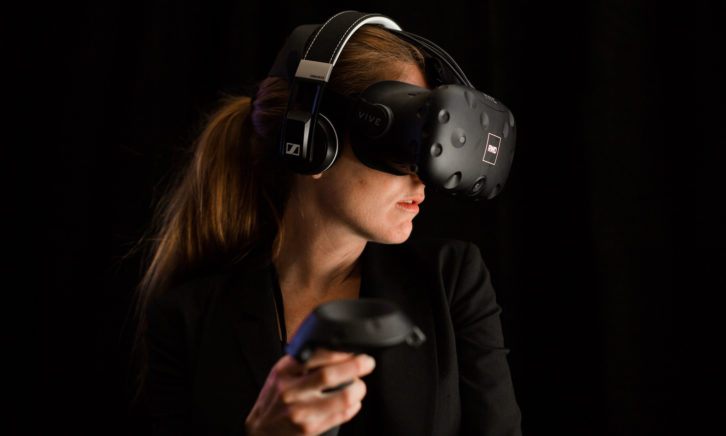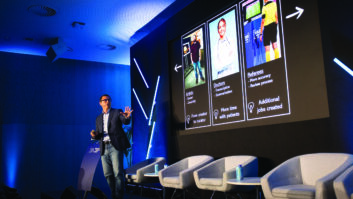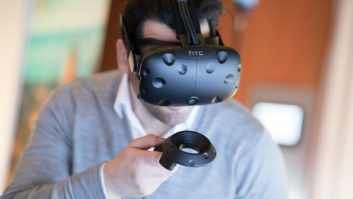
“With the application of some industry standards to prevent vendor lock-in, some easy tools for our customers to use to develop content, and support from larger manufacturers, this technology could be the next step from interactive touch in classrooms and lecture spaces,” says Spiros Andreou, service delivery manager at integrator CDEC. “We are, however, starting to see support from larger software companies -such as Microsoft’s Mixed Reality Portal. The AV industry also needs to step in with innovative and flexible technologies that can integrate with a customer’s existing equipment.”
Retail, as so often, is at the leading edge of AV technology – and there, XR has already established itself. “XR isn’t about the future – it’s already here,” states Thomas Walter, section manager, strategic product marketing at NEC Display Solutions Europe. “One example is the Lego AR solution in retail stores, where shoppers can hold the Lego box in front of an NEC large format display and they see the contents virtually displayed on the box, with all the parts fully assembled, set up and in motion. That allows shoppers to easily see what’s inside the box and what they can do with it. This application is up and running in multiple Lego stores around the world.”
Promise
And: it’s not just retail. “MR and AR show promise in delivering real business benefits,” notes Stuart Hetherington, CEO of Holovis. While pointing out that VR is far from ready for prime time in the business world for a number of reasons, “and are already being deployed and tested in enterprise sectors for applications such as design visualisation, virtual manufacturing and real-time data overlay and review. Some of these use cases are still operated in large tracked environments and range from data validation to real-time configurations and commissioning suites, photo realistic modelling, process validation, service and maintenance, digital twin and procedure tracking.”
“With AR, we are using it as a sales and marketing tool to demonstrate our capabilities and to help customers better understand what we are offering,” adds Frank Reynolds, marketing manager, Antycip Simulation. “For example, we use the AR capability on an iPad Pro to show customers what the projectors we are recommending would look like when set up in their proposed demo or VR room, or to show them the size of the screen that we are recommending. Elsewhere, we’ve seen AR being used in theme parks to improve customers’ experience in queues, by building on the content being shown on the existing displays; VR has been used to help sell season tickets for the new Spurs stadium; and to augment health and safety training on large scale building sites.”
Enhance – or create?
There is an extent, then, to which XR is already making its way into environments that are, if not exactly AV mainstream, then certainly adjacent to it. The question for many is: will XR simply augment/enhance existing AV applications, or will it create new ones?
Andreou is dubious about its ability to enhance unified communications – an application widely touted as a candidate for XR-ification.
“Initially, he says, “room users will be reluctant to wear devices that connect them to a virtual experience, especially given the size and bulk of wearable equipment that is on the market today. It will also be difficult to pitch XR technologies in meeting, collaboration or presentation spaces unless there is a very compelling use case, so it is hard to imagine how existing AV will be supplemented by XR to provide additional use cases.”
“However,” he continues, “in the future, should XR prove popular enough, it may be that components are integrated into commercial technology such as VC codecs in order to provide a more immersive experience for remote participants.”
On the other hand, as Hetherington points out – insofar as CAVEs are a collaborative environment, VR is a technology that is suited in specific instances to enabling improved understanding and communication.
Additional value
Walter sees opportunities for both enhancing existing applications and creating new ones. “There are applications which help to enhance an existing application with additional value for the user, such as virtual car configurators,” he observes. “We also see other applications that are new or replace existing technologies, such as virtual wellness resorts, where VR mixed with audio creates a relaxation space, with applications in offices and airport lounges to reduce stress.”
Reynolds has a clear vision of the way forward. “Today, AR is all about enhancing existing AV applications, such as entertainment events and venues using professional AV displays and who are adding to this through personalising the user’s experience and engagement with AR elements,” he believes. “Going forward, it will create new opportunities – but also disruption for the AV industry, as the new elements come from providers outside of the traditional AV industry. The future will be this blending of the shared experience and personalised experience that we’re currently seeing – but the balance or share between the two will vary, with the concern that the AV element becomes marginalised. Savvy AV companies today should be looking to have AR services or capabilities as part of their market offering, so that they can offer the full solution to clients in the future. This in turn will create new opportunities for them.”
The exact impact of XR technologies on the AV industry remains difficult to assess. Given the level of investment in them, and the excitement about their potential, they are for sure impossible to ignore – as are studies like the one from Statista that show the VR/AR market jumping from $27bn in 2018 to $209bn in 2022 – and it would be foolish for any industry participant not to track developments in the space, as Reynolds implies.
Hype
“There is still a lot of hype around the connection between XR and AV,” says Hetherington. “Of course, the industry definitely needs to be aware of the benefits and opportunities, while also appreciating that traditional AV, and the continuation of innovation and advancements in the core AV technologies, will still be the significant focus and requirement for corporate clients. Regardless of which platform you’re working with – VR, AR or MR – none are geared up for the large scale communications that have been the real strength of the AV industry: traditional AV systems, and especially secondary screens, will continue to be the primary focus for a long time yet.”
In all the discussion of XR, there appears to be a perception that AR and MR have the greater potential. So: what of VR? Will it ever have a role to play in the AV industry?
CDEC’s Andreou believes he sees a way forward. “I hope that we will see a ‘killer IDE’ – integrated development environment – or a ‘killer game engine’ such as Unity or Unreal Engine that allows hobby developers to produce content for VR very easily,” he says. “This kind of advancement would allow software houses to produce more commercial applications such as classroom journeys, simulation tools and interactive games in response to market demand from the education and corporate sectors.”
Way to go
For Ross Magri, managing director of Sarner, there is still a way to go, however, before Andreou’s vision can be realised. “We first need to see a killer hardware solution before software is considered,” he believes. “While the hardware remains so cumbersome and at times difficult to use, and with the quality just not being there – no matter how good the app is, it will always be limited by the processing power of the hardware.”
It’s hard to conclude anything other than that the jury is still out when it comes to XR and its impact on the AV industry. Yes, there are existing use cases, and successful deployments. It seems certain that retail, for example, or education/training applications can benefit from the new technologies. AV niche markets, such as healthcare, are promising candidates. MR and AR at the present time have significantly more potential than VR, if only because they are likely to prove easier to overlay on existing AV infrastructures.
There is enthusiasm and caution; excitement and concern; positive and negative views about the opportunity for XR in the AV industry. But then, as Hamlet famously said, continuing his musings on relativism and what precisely constitutes reality: “There is nothing either good or bad but thinking makes it so.”
www.antycipsimulation.com
www.cdec.co.uk
www.holovis.com
www.nec-display-solution.com
www.sarner.com







